A small, but hardy group of five Rochester Academy of Science mineral enthusiasts spent their Memorial Day weekend collecting minerals and mosquito bites in the Bancroft District of Ontario, the self-proclaimed mineral capital of Canada. Dick and Jeanne Phillips, Mario and Debbie Errico, and me made the 5 hour trip around Lake Ontario to Wilberforce and Bancroft for a whirlwind 3 days of rockhounding in the famous district. Dick led the group to 8 separate sites, including a night dig with black lights at the CN rock pile right in Bancroft.
After navigating around Toronto a quick stop at the Wilberforce Municipal Building informed us of the three public sites that were being promoted this season in that area. We signed the permissions slips and set out. The list included a new site (for Dick and Jeanne, they were all new to the rest of us) and we elected to start our collecting there. Millar’s Apatite Mine off Gibson’s Road was easily located and provided us with a first glimpse of the wonderfully variable and extremely coarse grained mineralogy of the region. As the mine name would suggest apatite is prevalent at the site. Much is the standard green color, but there is also red apatite. One large, but broken crystal I found was green in the central core, but red on the outside. The apatite is very hard to collect when distributed in the rock face (as below), but full, doubly terminated crystals can be scrounged in the dirt. My largest is half inch in diameter and almost two inches long, but I am sure larger are hiding at the site.
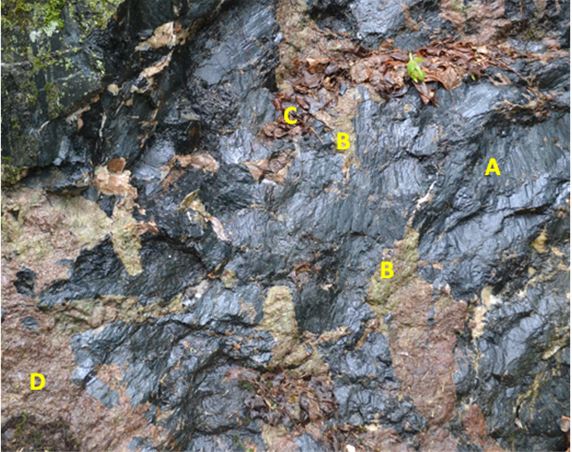
The primary minerals at Millar’s are tan to orange potassium feldspar (likely microcline), a black amphibole, composition unknown to us and not reported on mindat either, and calcite. The amphibole resembles the fluoro-richterite from the nearby Essonville roadcut, which we also visited (see right side of cover photo), but is generally less lustrous and more deeply etched. Perhaps it is more properly labeled hornblende (a mixed composition black amphibole that is not a recognized mineral). According to the mindat entry for the location, the mine was active around 1900 when radioactive minerals and apatite were recovered from “calcite veins cutting graphic granite pegmatite”.
We struck out in light rain trying to find the Desmont Mine, another of the Wilberforce suggestions. We think we did not stay on our first trail attempt quite far enough up the hill, and naturally did not find it when we diverted to another trail. Perhaps fortunate, for we arrived back at the cars just as the rain clouds decided they were too saturated to hold their water. We would have been soaked to the skin had we found the location and commenced collecting.
Fortunately, it cleared as we approached the Schickler Mine on Mumford Road east of Wilberforce. This is a favorite of the Wayne County Gem and Mineral club for the purple fluorite that is laced through cream white calcite. Most fluorite surfaces are cleavage faces, but the color is intense. As at Millar’s Mine, this property is primarily a calcite vein and it was exploited for apatite and radioactive minerals. The host is a hornblende gneiss and the mafic character of the host is manifested by large augite and amphibole crystals in the vein material. Scapolite is also noted there, although I do not believe we have any in our samples, at least none fluoresce like a scapolite group mineral typically does.
An excellent location to become oriented in the region’s geology and mineral diversity is at the Bancroft Mineral Museum, recently refurbished in the old train station. Exhibits highlight the minerals regionally with world class examples to whet ones collecting apatite. We all enjoyed a morning stop there on our second day, but did not stay as the rocks called.


Geologically, the “Ontario Highlands” are very similar to the upstate New York equivalent region in St. Lawrence County. About 1.1 Billion years ago the existing sedimentary rocks of both regions were buried during a continental collision event of the scale of the modern day Himalaya Mountains. This event, termed the Grenville orogeny, buried the limestones, shales, and siltstones several kilometers. The entire sequence was metamorphosed at temperatures exceeding 500C and at several kilobars of pressure. At the same time igneous bodies of various sizes and compositions intruded the region creating contact aureoles as they virtually cooked the adjacent country rock. Now exposed by erosion, the result is a veritable geologic smorgasbord of metamorphic rock and minerals. Nearly 300 mineral species have been identified in the Bancroft region.
It is one of those igneous intrusive events that is responsible for the wondrously rich mineral assemblage at the Beryl Pit and the gorgeous rose quartz in the Rose Quartz pit a few miles away. Both pegmatite occurrences are located in Quadville. We met the owners in “town” and proceeded to the Rose Quartz pit to start day 2. David and Renee Paterson purchased both sites about 15 years ago and moved from outside Toronto to enjoy operating them as mineral collecting sites in their retirement. David explained that the pegmatites on their properties are properly classified as NYF pegmatites as they are enriched in niobium, yttrium, and fluorine. That means one won’t find lithium minerals like lepidolite and spodumene that are found in LCT pegmatites (lithium, cesium, and tantalum) like those in the Black Hills of South Dakota.
The rose quartz is among the finest in the world for both color and clarity. There was an incremental pound charge for rose quartz above the visit fee, but we all left with several pieces and a few less loonies in pockets. The cause of the coloration in pegmatitic rose quartz has been disputed in the past but recently most seem to accept that the color is not caused by elemental substitution in the quartz lattice or by some sort of irradiation. Rather it seems that minute amounts of dispersed dumortierite (an aluminum, iron bearing boro-silicate) is the cause and that as little as 0.05% of the fibrous mineral distributed within the quartz causes the pink color. (http://www.quartzpage.de/rose.html) Interestingly, rose quartz is always massive and never crystalline. The process of crystal growing seems to preclude the inclusion of the dispersed dumortierite.
Rose quartz was not the only mineral attraction at the locale. We all also enjoyed collecting columbite (which occurs as crystals and as sprays through the rock), biotite, and perthitic microcline as well. The perthite from the very large microcline “crystals” breaks out along cleavage surfaces into attractive angular prisms. Some of the microcline crystals in the pit wall are as large as vans.
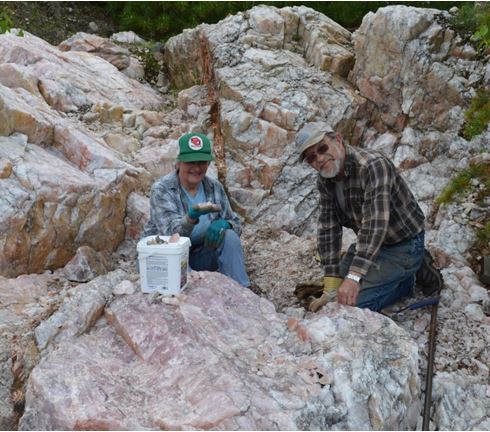
- I staked my own frose quartz claim only to learn that the owners were not allowing collecting of that pod just yet. But pictures were OK!
In the afternoon we proceeded to the Beryl pit where the Paterson’s had blasted six feet into the pit floor last summer to loosen and expose fresh pegmatite. Mario is standing on the blasted pit floor on the left side of the cover photo above. Amazonite (green microcline) was scattered in the rubble as were the famous beryl crystals for which the pit is named. They are not gemmy, but certainly collectible and often associated with cleavandite, schorl, and microcline for some nice ascetic pieces. The black schorl set against the white cleavandite and orange microcline is particularly eye pleasing, especially when some transparent or milky quartz is mixed into the assemblage.
We all made sure to collect a bit of euxenite, which set off Dick’s geiger counter, but Debbie found the best specimen simply sifting in the dirt. David thought her crystal one of the better he had seen and said it might even be aeschynite based on its habit. Whichever it is, the 2” terminated rare earth oxide should clean up very nicely for her collection. We each made two trips out with our packs and buckets full of mineral specimens and garden rocks.
We hustled on the way into town to arrive at the Princess Sodalite Mine store 5 minutes before closing. Mario found a large biotite book he had to have and most of us “collected” the famous blue sodalite from the rock pile adjacent to the store. While there a local collector appeared who had spent his day collecting andradite garnet at the Marmoraton Open Pit in Marmora Township. Another place to to?
One can even collect in town in Bancroft. Parking behind the large grocery store in Bancroft it is possible to prospect the Ireland Property. The story goes that a few years back the site was opened as a large department store was destined for the location. But the land was too swampy for development and the rocks exposed by the preparation work now lay exposed for mineral collecting. The new outcrop exposes the contact between marble and a feldspar rich granitic intrusion. The exposed surfaces contain lots and lots of what most in the area would call “Grenville grunge”, i.e. large intergrown grains with few true crystals, but nevertheless colorful enough for “foreigners” like us to bring home to our gardens. Red stained drusy quartz and coarsely crystalline orange calcite with minor embedded apatite and pyrite was also found.
Of course, one cannot stay in Bancroft and not visit the CN Rock Pile. The town has moved mine dump material from the Goulding-Keene Quarry 10 kilometers east of town to an accessible location on the Hastings Heritage Trail off of Station Street. We visited at dusk so we could identify hackmanite by black light. Hackmanite is a variety of sodalite that displays tenebresence, the repeatable ability to change color when exposed to sunlight. Although off white to dull grey in plane light and virtually indistinguishable from the albite that dominates the site the CN rock pile hackmanite also fluoresces reddish to short-wave UV. I’ve hidden mine from any light source and will check periodically to see if color returns. Zircons also were located on the dump by their yellow fluorescence. Lots of garden variety biotite set in a matrix of albiite and nepheline on the dump and some other small fluorescent minerals that we think are cancrinite.
The final day of the trip we all felt ambitious so we set out on the one mile plus trek towards the Silver Crater Mine. Just when we were about to give up, we stumbled on the flooded adit and dumps. Yet another geologic anomaly, this location is thought to be a carbonatite intrusion with radioactive minerals and other goodies encased in coarse grained calcite. And surrounded by mosquitoes and black flies, I might add. The prize here is supposed to be the rare-earth Pyrochlore Group mineral betafite. We may have all found it, or none of us may have found it. There were lots (and lots) of brown to black biotite and brown to black hornblende and a bit of black tourmaline to hide any brown-black betafite from our untrained eyes. We did find specks of molybdenite. Conscious of a long hike out we packed up what we could carry, re-applied bug repellent and trekked out.
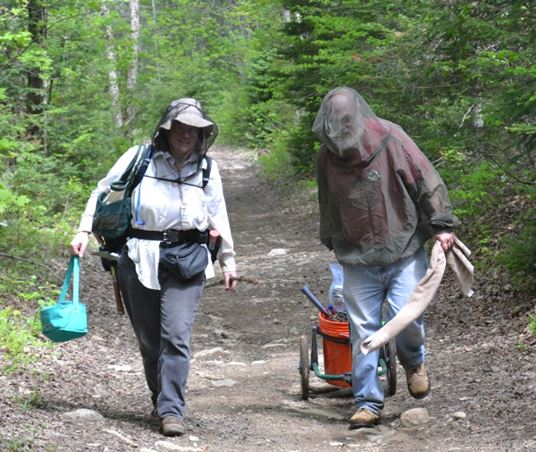
- Rocks are not the only pretty things in the Ontario Highlands. White and purple trilliums were all along the trail to Silver Crater.
A final stop at the Faraday Hill Roadcut on Monck Road (apatite and orange calcite) and we called it a trip. Several hours later the US customs let us come home with our rocks and black fly bites.
REFERENCES:
Fouts.C., and Lablans, C., 2013, Bancroft Regional Mineral Collecting Guidebook, 2103: published by Bancroft District Chamber of Commerce, 69 p.
Mindat.com, Various Bancroft location sites on mindat website.
Simmons, S., 2005, A Look at Pegmatite Classifications, MSA special webpage publication
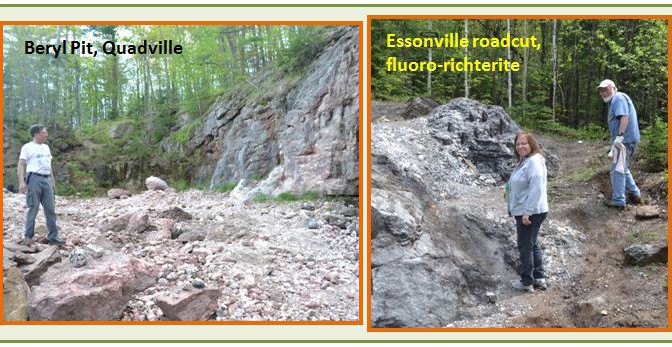
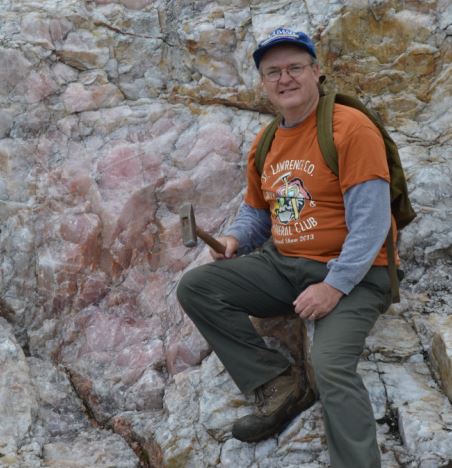

I cannot believe customs allowed you back without hassle due to radioactive minerals. You must not have had much. I tried to return once with some betafite, thorite and euxenites. They took it all away from me. Unfortunately I had some nice corundum from Burgess mine mixed in as well. All gone. I spent 3 hours as a customs agent searched the vehicle to make sure it was free of such terrorism!!!
🙁
Have not visited my comments in months and just saw this. WOW. When was this and what customs station was it? I did not have too much, but I did have enough to kick off their counter. Most was euxinite which, I think, is less radioactive than thorite or betafite. Next time I came back with some I had it all separated into a flat to show them if they asked, but apparently we did not kick the meter and it did not come up. I will remember your experience next time. However, perhaps best not to attempt radioactive mineral collecting. Hard to avoid at places like Beryl Pit however.